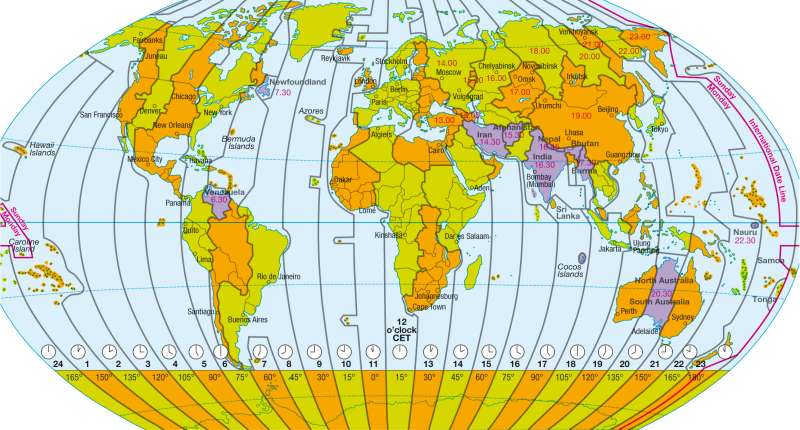Time zones
The world - Tourism
978-3-14-100790-9 | Page 197 | Ill. 3

Information
In the mid-19th Century a rapid expansion of railway and telegraph networks took place worldwide. The resulting internationalisation of cash and commodity flow had a significant impact on the world economy and trade. The age of mass production had begun; large stock exchanges experienced their first boom period while many joint stock companies and corporations sprung up in the developed countries.The globalisation of telecommunication via the transatlantic telegraph cable and other transnational networks, as well as the rapid increase of ship and rail traffic intensified the desire for a uniform system of world time. In 1884, representatives of 25 nations met in Washington for the International Meridian Conference, at which it was decided to divide the world into 24 time zones each with a geographical longitude of 15 degrees. The conference declared the Greenwich Meridian — which at the time was already denoted on many nautical maps as having a longitude of zero degrees — as the prime meridian. The mean time zone stretches from 7.5 degrees west to 7.5 degrees east of the Greenwich Meridian. It was also decided that the International Date Line would follow the meridian at 180 degrees longitude.
Most nations have since adopted this system of world time, whereby the boundaries of the time zones are often aligned to the political borders. Only a few oceanic islands and a handful of nations such as Iran, Afghanistan, India and Myanmar do not adhere to the system of world time. In 1930 the former Soviet Union introduced so-called "decree time". In order to make better use of the daylight hours all clocks were permanently shifted one hour ahead in each time zone — a system similar to "Summer Time" also referred to as "Daylight Saving". In many parts of the former USSR decree time was abolished in the 1980s and in the remaining regions in 1991 — only to be reintroduced by Russia immediately afterwards. For this reason Summer Time is not observed in Russia.
On an international scale Summer Time is observed in relatively few countries, in Europe however it is the norm. The start and end dates of summer time are prescribed by the EU for all its member states — it usually begins on the last Sunday in March and ends on the last Sunday in October.
K. Lückemeier; Ü: J. Moar, M. Dahl




